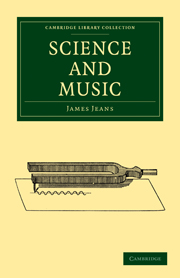Chapter III - The Vibrations of Strings and Harmonics
Published online by Cambridge University Press: 07 September 2010
Summary
We began our study of sound-curves by examining the curve produced by a tuning-fork. A tuning-fork was chosen, because it emits a perfectly pure tone. But, as every musician knows, its sound is not only perfectly pure, but is also perfectly uninteresting to a musical ear—just because it is so pure.
The artistic eye does not find pleasure in the simple figures of the geometer—the straight line, the triangle or the circle—but rather in a subtle blend of these in which the separate ingredients can hardly be distinguished. In the same way, the painter finds but little interest in the pure colours of his paint-box; his real interest lies in creating subtle, rich or delicate blends of these. It is the same in music; our ears do not find pleasure in the simple tones we have so far been studying but in intricate blends of these. The various musical instruments provide us with readymade blends, which we can combine still further at our discretion.
In the present chapter we shall consider the sounds which are emitted by stretched strings—such as, for instance, are employed in the piano, violin, harp, zither and guitar—and we shall find how to interpret these as blends of the pure tones we have already had under consideration.
Experiments with the Monochord
Our source of sound will no longer be a tuning-fork but an instrument which was known to the ancient Greek mathematicians, Pythagoras in particular, and is still to be found in every acoustical laboratory—the monochord.
- Type
- Chapter
- Information
- Science and Music , pp. 61 - 106Publisher: Cambridge University PressPrint publication year: 2009First published in: 1937

